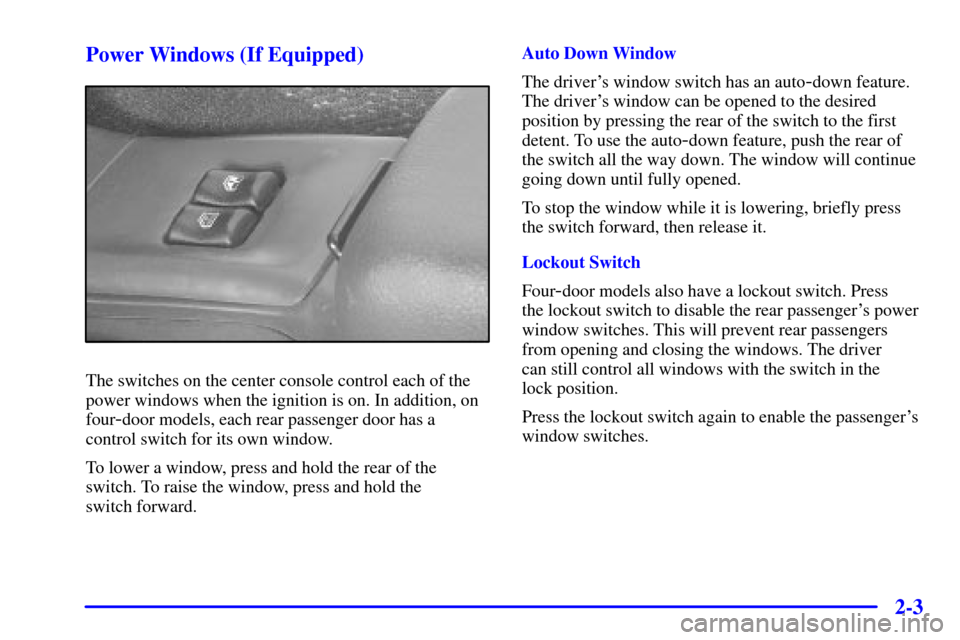Page 69 of 357

2-3 Power Windows (If Equipped)
The switches on the center console control each of the
power windows when the ignition is on. In addition, on
four
-door models, each rear passenger door has a
control switch for its own window.
To lower a window, press and hold the rear of the
switch. To raise the window, press and hold the
switch forward.Auto Down Window
The driver's window switch has an auto
-down feature.
The driver's window can be opened to the desired
position by pressing the rear of the switch to the first
detent. To use the auto
-down feature, push the rear of
the switch all the way down. The window will continue
going down until fully opened.
To stop the window while it is lowering, briefly press
the switch forward, then release it.
Lockout Switch
Four
-door models also have a lockout switch. Press
the lockout switch to disable the rear passenger's power
window switches. This will prevent rear passengers
from opening and closing the windows. The driver
can still control all windows with the switch in the
lock position.
Press the lockout switch again to enable the passenger's
window switches.
Page 70 of 357
2-4
Keys
CAUTION:
Leaving children in a vehicle with the ignition
key is dangerous for many reasons. A child or
others could be badly injured or even killed.
They could operate the power windows or other
controls or even make the vehicle move. Don't
leave the keys in a vehicle with children.
Page 79 of 357

2-13
Trunk
To unlock the trunk from the outside, insert the key and
turn the trunk lock cylinder or use the remote keyless
entry transmitter (if equipped).
When closing the trunk, close from the center to ensure
it fully latches.
CAUTION:
It can be dangerous to drive with the trunk lid
open because carbon monoxide (CO) gas can
come into your vehicle. You can't see or smell
CO. It can cause unconsciousness and even death.
If you must drive with the trunk lid open or if
electrical wiring or other cable connections must
pass through the seal between the body and the
trunk lid:
�Make sure all other windows are shut.
CAUTION: (Continued)
CAUTION: (Continued)
�Turn the fan on your heating or cooling
system to its highest speed with the setting
on any airflow selection except MAX. That
will force outside air into your vehicle. See
ªComfort Controlsº in the Index.
�If you have air outlets on or under the
instrument panel, open them all the way.
See ªEngine Exhaustº in the Index.
Remote Trunk Release (If Equipped)
Pull upward on the remote
release handle, located on
the floor near the left side of
the driver's seat, to release
the trunk lid.
Page 81 of 357

2-15 Key in the Ignition
If you leave your vehicle with the keys inside, it's an
easy target for joy riders or professional thieves
-- so
don't do it.
When you park your vehicle and open the driver's door,
you'll hear a chime reminding you to remove your key
from the ignition and take it with you. Always do this.
Your steering wheel will be locked, and so will your
ignition. If you take the key with you, and you have an
automatic transaxle, it will be locked. And remember to
lock the doors.
Parking at Night
Park in a lighted spot, close all windows and lock your
vehicle. Remember to keep your valuables out of sight.
Put them in a storage area, or take them with you.
Parking Lots
Even if you park in a lot where someone will be
watching your vehicle, it's still best to lock it up and
take your keys. But what if you have to leave your key?
�If possible, park in a busy, well
-lit area.
�Put your valuables in a storage area, like your
trunk or glove box. Be sure to close and lock the
storage area.
�Close all windows.
�Lock all the doors except the driver's.
�If your vehicle has a remote keyless entry system,
take the transmitter with you.
Page 101 of 357
2-35
Parking Over Things That Burn
CAUTION:
Things that can burn could touch hot exhaust
parts under your vehicle and ignite. Don't park
over papers, leaves, dry grass or other things that
can burn.
Engine Exhaust
CAUTION:
Engine exhaust can kill. It contains the gas
carbon monoxide (CO), which you can't see or
smell. It can cause unconsciousness and death.
You might have exhaust coming in if:
�Your exhaust system sounds strange
or different.
�Your vehicle gets rusty underneath.
�Your vehicle was damaged in a collision.
�Your vehicle was damaged when driving over
high points on the road or over road debris.
�Repairs weren't done correctly.
�Your vehicle or exhaust system had been
modified improperly.
If you ever suspect exhaust is coming into
your vehicle:
�Drive it only with all the windows down to
blow out any CO; and
�Have your vehicle fixed immediately.
Page 115 of 357
2-49 Breakaway Mirrors
Should the mirror control lever not operate the mirror
adjustment, you can reset the adjustment lever on the
driver's side mirror only, by following these steps:
A. Adjustment Lever T End
B. Lever Slide
C. Mirror
D. Spring
E. Adjustment Lever Handle1. Roll down the left door window.
2. Fold the mirror toward the front of the vehicle. Hold
the mirror in position with your left hand.
3. With your right hand, move the adjustment lever
handle (inside the vehicle) in order to align the T end
of the lever with the lever slide.
4. Fold the mirror back to the original position in order
to engage the T end of the lever with the lever slide.
5. Make sure the mirror housing is fully seated to
its base.
Storage Compartments
Center Console Storage Area
To open the center console, pull the lift lever up and the
lid back.
To close the center console, push the lid down until
it clicks.
Page 119 of 357
2-53
The main components of your instrument panel are the following:
A. Fog Lamp Switch (If Equipped)
B. Instrument Panel Intensity Control
C. Turn Signal/Multifunction Lever
D. Instrument Panel Cluster
E. Hazard Warning Flashers Switch
F. Ignition Switch
G. Windshield Wiper/Washer Controls
H. Cigarette Lighter (If Equipped)I. Audio System
J. Climate Controls and Rear Window Defogger
K. Fuse Panel
L. Hood Release Lever
M. Tilt Steering Wheel Lever (If Equipped)
N. Parking Brake Lever
O. Shift Lever
Page 136 of 357

3-
3-1
Section 3 Comfort Controls and Audio Systems
In this section, you'll find out how to operate the comfort control and audio systems offered with your vehicle.
Be sure to read about the particular systems supplied with your vehicle.
3
-2 Comfort Controls
3
-5 Air Conditioning (If Equipped)
3
-5 Heating
3
-5 Defogging and Defrosting
3
-6 Rear Window Defogger (If Equipped)
3
-7 Ventilation System
3
-8 Audio Systems
3
-8 Setting the Clock for Systems without
Radio Data System
3
-8 Setting the Clock for Systems with Radio
Data System
3
-9AM-FM Stereo
3
-12 AM-FM Stereo with Compact Disc Player
(If Equipped)3
-16 AM-FM Stereo with Cassette Tape and
Compact Disc Player with Radio Data
System (RDS) and Automatic Tone Control
(If Equipped)
3
-27 Theft-Deterrent Feature RDS Radios
(If Equipped)
3
-27 Theft-Deterrent Feature Non-RDS Radios
(If Equipped)
3
-28 Understanding Radio Reception
3
-28 Tips About Your Audio System
3
-29 Care of Your Cassette Tape Player
3
-30 Care of Your Compact Discs
3
-31 Care of Your Compact Disc Player
3
-31 Fixed Mast Antenna
3
-31 Chime Level Adjustment (RDS Radios Only)